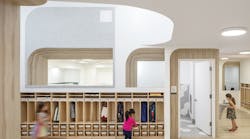Other solutions are available that enable a variation in the beam angle without exchanging components, but they are inefficient and can be complex. In some cases it’s possible to shift the lens away from the LED to focus the beam (up to a certain point). However, rings and shadows typically appear in the spot, and a lot of light is lost as the distance from the LED increases.
On the other hand, large show-lights or even some museum lights are equipped with a zoom lens for spot-size adjustment. As well as requiring lots of space and being inefficient, such zoom lenses are expensive in development and manufacturing, making them unsuitable for mass lighting applications.
Tunable lenses
The tunable-lens technology developed by Optotune allows the beam angle to be set on site and to be adjusted whenever necessary. There is even the possibility of motorizing the tuning process for remote-controlled adjustments.
The principle of the tunable-lens technology is outlined in Fig. 1. A ring, or so-called lens shaper, is pressed into a polycarbonate container filled with an optical liquid and sealed with a thin polymer membrane. This causes a spherical lens to form. The focal length of the lens changes in proportion to the liquid pressure. The clear aperture remains constant throughout the whole tuning range.
While being very efficient and compact, this technology allows a flexible adjustment of the beam angle when implemented in a spotlight. Turning a ring controls the movement of the lens shaper into the liquid-filled container and therefore the shape of the lens. A cogwheel in the housing offers the possibility of motorizing this process, enabling remote control of the beam angle.
Optical design
Fig. 3 shows a spotlight design using Optotune’s ML-25-50 Lumilens, illustrating the compact design possibilities for a spotlight. The optical design of a spotlight with a tunable lens is outlined in Fig. 2. The LED and the secondary optics define the maximum beam angle. It’s important to use secondary optics with an even light distribution for a good tuning result. The tunable lens is then used to focus the beam from the wide flood angle to a narrow spot beam. For the spotlight design presented here, the beam-angle range goes from 40° down to 10°, but this range varies according to the design and optical components used.
The lens in Fig. 3 is one of Optotune’s standard products, which has a clear aperture of 25 mm with an outer diameter of 50 mm. The largest lens currently available has a clear aperture of 55 mm, designed for large LED spotlights with lighting power of 2000-4000 lm. Prices for these standard lenses start at around EUR 20-30 depending on the volume and lens size. Technologically, it would be possible to build even larger lenses, or lenses as small as a 2-mm aperture.








